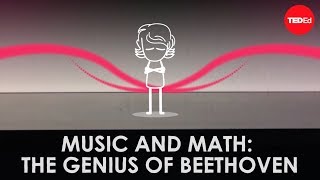(单词翻译:单击)
It may sound like a paradox, or some cruel joke, but whatever it is, it's true.
听上去自相矛盾,像个残酷的玩笑,但不管怎样,我接下来要说的是真的。
Beethoven, the composer of some of the most celebrated music in history, spent most of his career going deaf.
贝多芬,创作了许多历史上最著名的乐曲,而他的大部分创作生涯却是在失聪中度过的。
So how was he still able to create such intricate and moving compositions?
那他是如何创作出如此错综复杂却美妙动人的乐曲呢?
The answer lies in the patterns hidden beneath the beautiful sounds.
答案就在这些美妙音符背后所隐藏的规律中。
Let's take a look at the famous 'Moonlight Sonata,'
我们以那首著名的《月光奏鸣曲》为例,
which opens with a slow, steady stream of notes grouped into triplets: One-and-a-two-and-a-three-and-a.
开头的一段节奏缓慢而音阶稳定,以三个音符为一组:一哒哒,二哒哒,三哒哒...
But though they sound deceptively simple, each triplet contains an elegant melodic structure,
虽然表面上听上去简单不过,但每组三连音中都包含一个优雅唯美的旋律结构,
revealing the fascinating relationship between music and math.
揭示出音乐和数学两者间极为有趣的关联。
Beethoven once said, 'I always have a picture in my mind when composing and follow its lines.'
贝多芬曾说:“作曲时,我脑海里总有一幅画面,我就沿着画上的线条来谱曲。”
Similarly, we can picture a standard piano octave consisting of thirteen keys, each separated by a half step.
同样我们可以想像,一个标准钢琴键盘,由十三个琴键组成一个八度,每对相邻琴键中间隔半个音。
A standard major or minor scale uses eight of these keys, with five whole step intervals and two half step ones.
一个标准大调或小调音阶用到这其中的八个键,音阶中包含五个全音音程和两个半音。
And the first half of measure 50, for example, consists of three notes in D major,
比如,第50小节的前半段由D大调的三个音符组成,
separated by intervals called thirds, that skip over the next note in the scale.
它们之间的音程是三度,也就是说跳过音阶中的下一个音。
By stacking the scale's first, third and fifth notes, D, F-sharp and A, we get a harmonic pattern known as a triad.
把音阶的第一、三、五个音符(D,升F,A)叠加在一起,我们就有了一个和谐的旋律--三和弦。
But these aren't just arbitrary magic numbers.
但是这些并非任意的数字。
Rather, they represent the mathematical relationship between the pitch frequencies of different notes which form a geometric series.
相反,它们其实代表了不同音符的频率之间的数学关系,这些频率构成一个等比数列。
If we begin with the note A3 at 220 hertz, the series can be expressed with this equation,
如果我们从频率为220赫兹的音符A3开始,可以用函数f=ar^n来表达这个数列,
where 'n' corresponds to successive notes on the keyboard.
其中n代表键盘上连续的几个键。

The D major triplet from the Moonlight Sonata uses 'n' values five, nine, and twelve.
《月光奏鸣曲》中的D大调三连音是以n值为5,9,12。
And by plugging these into the function, we can graph the sine wave for each note,
把这几个n值带入函数中,就可以画出每个音符的正弦曲线,
allowing us to see the patterns that Beethoven could not hear.
我们就能看够看到贝多芬听不到的规律。
When all three of the sine waves are graphed,
当我们把三个正弦曲线都画出来时,
they intersect at their starting point of 0,0 and again at 0,0.042.
他们在原点0,0相交,然后又在0,0.042相交。
Within this span, the D goes through two full cycles,
在同等距离里,D调完成了两周循环,
F-sharp through two and a half, and A goes through three.
升F完成了两个半,A为三个循环。
This pattern is known as consonance, which sounds naturally pleasant to our ears.
这个旋律被称为和弦音程,听起来自然动听,悦耳怡人。
But perhaps equally captivating is Beethoven's use of dissonance.
但贝多芬对不和谐音的运用同样充满魔力,令人神往。
Take a look at measures 52 through 54, which feature triplets containing the notes B and C.
在52到54小节中,主三连音中包含了B音和C音。
As their sine graphs show, the waves are largely out of sync, matching up rarely, if at all.
于是在它们的正弦曲线中波动起伏比和弦要更为激烈,极难相配,几乎没有。
And it is by contrasting this dissonance with the consonance of the D major triad in the preceding measures
通过将不和谐音程与之前乐章的D大调三和弦进行对比,
that Beethoven adds the unquantifiable elements of emotion and creativity to the certainty of mathematics,
贝多芬在数学的确定性当中增加了不可量化的元素,即情感和创造力,
creating what Hector Berlioz described as 'one of those poems that human language does not know how to qualify.'
创作出了被埃克托·柏辽兹称为“人类语言无资格颂唱的诗歌之一”。
So although we can investigate the underlying mathematical patterns of musical pieces,
因此,尽管我们可以研究乐章背后隐藏的数学规律,
it is yet to be discovered why certain sequences of these patterns strike the hearts of listeners in certain ways.
但为什么这些旋律以某种顺序呈现出的时候能够如此深入人心,仍有待发掘。
And Beethoven's true genius lay not only in his ability to see the patterns without hearing the music, but to feel their effect.
而贝多芬真正的音乐天赋不仅在于未闻音乐就能辨识旋律,更在他对音乐效果的感知力。
As James Sylvester wrote, 'May not music be described as the mathematics of the sense, mathematics as music of the reason?'
正如詹姆斯·西尔维斯特所写得“也许音乐不能被描绘为有情感的数学,但也许数学可以是有理智的音乐?”
The musician feels mathematics. The mathematician thinks music.
音乐家可以感知数学。数学家能够思考音乐。
Music, the dream. Mathematics, the working life.
音乐,如梦之中,人生之幻。数学,大梦易醒,人生之实。


